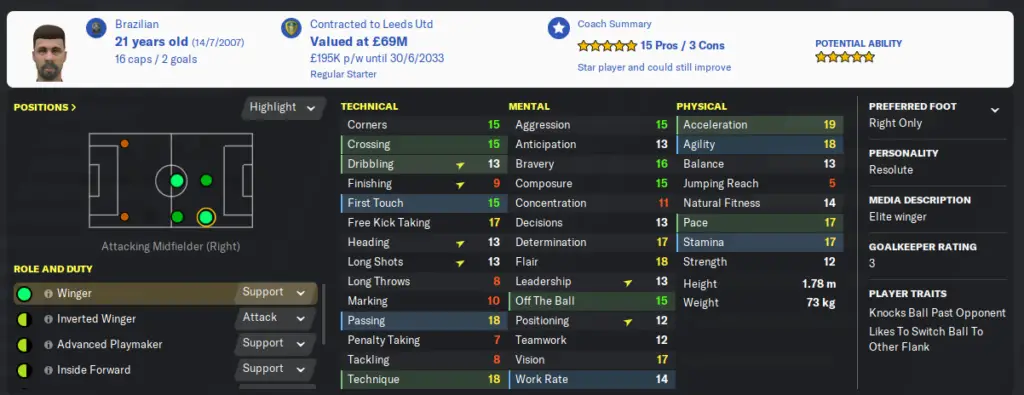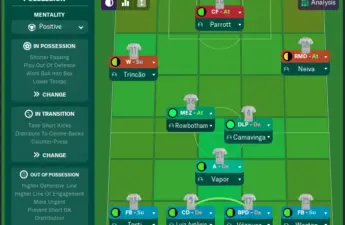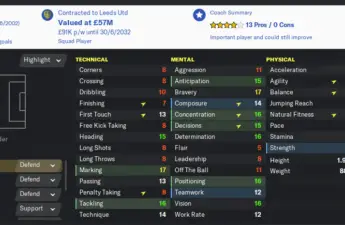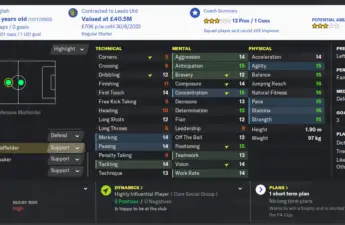A winger in football manager aims to beat his man on the outside and needs to be technically proficient as well as quick in order to do so.
He will hug the touchline when the team is going forward, ready to surge into space and attack the byline.
With the rise of inverted wingers, inside forwards and attacking wing-backs, the traditional out-and-out wingers have become a dying breed.
Not many teams these days play with wingers hugging the touchline and sending in crosses for the team’s target man, advanced forward or the deep-lying forward to attack.
The preference is to have inside forwards in the mould of Mohammed Salah or inverted wingers like Riyad Mahrez who will both cut inwards into the central areas of the pitch, vacating the flank for an overlapping wing-back.
However, there are still teams that play with traditional wingers, enjoying relative success, including Dwight McNeil previously of Burnley now plying his trade at Everton.
Back at Burnley, McNeil was part of a rigid 4-4-2 system that relied on two big no.9s to get the goals, and in the traditional winger role, McNeil played a huge role in sending in floated crosses and progressing play up the pitch.
Wingers In FM
To effectively use a winger in football manager, you would obviously first need a system that creates space for the winger to operate in, opening up opportunities for regular 1-v-1s against the opposition fullback.
A counter-attacking system for instance ensures the searing pace that traditional wingers should have is put to great use compared to a system that has upwards of 70% possession which pins the opposition back in their own half and leaves no room for a winger to work with.

The second thing you should look at is the role you assign the fullback behind your winger. You do not want a fullback that is too attacking and pushes forward into the spaces that your winger should be operating from.
Therefore, have your fullback in a support duty and avoid the overly attacking roles like wing back and the complete wing back. You can however experiment with an inverted wing back as he will be pushing into the central midfield areas rather than along the touchline.
Once you have the set up right, the next thing is to have the right number of players who will be making runs into the box to attack the crosses being sent in.
You do not want your winger to be sending crosses into the box with only a single striker to aim at.
Two striker systems like 4-4-2 or 4-2-4 guarantee that you will have multiple players in the 18-yard box to target. However, if you are playing a lone striker system, having other players in roles that encourage late runs into the box is an effective way of increasing the number of players in the box.
A shadow striker, box-to-box midfielder and a central midfielder on attack duty will make those kinds of runs into the box to meet the crosses, knockdowns from a target man or cutbacks from out wide.
The final thing you should consider is the player traits that your winger has. A winger should stretch the play, and if your preferred player has player traits that encourage a different kind of play like cutting inwards, then you are better off playing that particular player in a different role like inside forward or raumdeuter
The right kind of player traits for a winger in football manager are as follows;
- Hugs line – By hugging the line, you get to stretch the opposition’s backline, creating space for other attackers.
- Knocks ball past opponent – This is a useful player trait if your winger has very high pace and acceleration with slightly less than ideal dribbling stats
- Runs with ball down Right/Left – Encourages the winger to run with the ball down the flanks instead of cutting inwards.
- Gets forward whenever possible – The player will more often make his way into the final third, regularly joining the attack
- Crosses early – Crossing early benefits quick-footed attackers that will time their runs and get in behind the defence before the defenders can react.
Winger Attributes In Football Manager
Obviously, the most essential asset that a traditional winger possesses is his crossing ability. For the top five leagues, only consider wingers with at least 15 in crossing.
The crossing ability is then complemented by the winger’s other technical skills like dribbling, technique, first touch and passing.
These attributes should also be in the 15 range, however, having one or two lower than 15 is not a dealbreaker.
On the mental attributes, off-the-ball movement is paramount for your winger to pop out in the right spaces, while work rate is equally important for when the team is out of possession.
If you are on using the attack duty, flair and anticipation also come into play as your winger will be making more runs into the box when the ball is on the other flank.
On the physical side, acceleration and pace are key. You should have wingers that have 17 and above in both these attributes unless they have very good dribbling skills that they can get away with less than ideal pace.
The very best wide players in the world have bags of pace, and football manager is no different.
To go with the searing pace, your winger should have good agility to evade challenges while good stamina is useful if you want your player to sustain the good work for the whole 90 minutes
A good attribute rating in natural fitness is not as important, however, it plays a key role in your players getting ready and rejuvenated for the next game.


